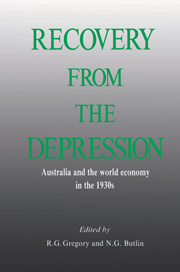Book contents
- Frontmatter
- Contents
- LIST OF AUTHORS
- LIST OF FIGURES
- LIST OF TABLES
- PREFACE
- 1 AN OVERVIEW
- 2 THE AUSTRALIAN RECOVERY OF THE 1930s IN INTERNATIONAL COMPARATIVE PERSPECTIVE
- 3 THE RECOVERY OF THE 1930s AND ECONOMIC POLICY IN BRITAIN
- 4 A MACRO INTERPRETATION OF RECOVERY: AUSTRALIA AND CANADA
- 5 DEPRESSION AND RECOVERY IN NEW ZEALAND
- 6 THE JAPANESE ECONOMY AND ECONOMIC POLICY IN THE 1930s
- 7 THE BATTLE OF THE PLANS: A MACROECONOMETRIC MODEL OF THE INTERWAR ECONOMY
- 8 AUSTRALIAN BUDGETARY POLICIES IN THE 1930s
- 9 MONETARY POLICY IN DEPRESSION AND RECOVERY
- 10 SHARING THE BURDEN: THE AUSTRALIAN LABOUR MARKET DURING THE 1930s
- 11 MANUFACTURING AND ECONOMIC RECOVERY IN AUSTRALIA, 1932–1937
- 12 AGRICULTURE AND THE RECOVERY FROM THE DEPRESSION
- 13 UNEMPLOYMENT AND THE AUSTRALIAN ECONOMIC RECOVERY OF THE 1930s
- 14 GOVERNMENT UNEMPLOYMENT RELIEF IN THE 1930s: AID OR HINDRANCE TO RECOVERY?
- 15 UNEQUAL SACRIFICE: DISTRIBUTIONAL ASPECTS OF DEPRESSION AND RECOVERY IN AUSTRALIA
- REFERENCES
- INDEX
2 - THE AUSTRALIAN RECOVERY OF THE 1930s IN INTERNATIONAL COMPARATIVE PERSPECTIVE
Published online by Cambridge University Press: 24 November 2009
- Frontmatter
- Contents
- LIST OF AUTHORS
- LIST OF FIGURES
- LIST OF TABLES
- PREFACE
- 1 AN OVERVIEW
- 2 THE AUSTRALIAN RECOVERY OF THE 1930s IN INTERNATIONAL COMPARATIVE PERSPECTIVE
- 3 THE RECOVERY OF THE 1930s AND ECONOMIC POLICY IN BRITAIN
- 4 A MACRO INTERPRETATION OF RECOVERY: AUSTRALIA AND CANADA
- 5 DEPRESSION AND RECOVERY IN NEW ZEALAND
- 6 THE JAPANESE ECONOMY AND ECONOMIC POLICY IN THE 1930s
- 7 THE BATTLE OF THE PLANS: A MACROECONOMETRIC MODEL OF THE INTERWAR ECONOMY
- 8 AUSTRALIAN BUDGETARY POLICIES IN THE 1930s
- 9 MONETARY POLICY IN DEPRESSION AND RECOVERY
- 10 SHARING THE BURDEN: THE AUSTRALIAN LABOUR MARKET DURING THE 1930s
- 11 MANUFACTURING AND ECONOMIC RECOVERY IN AUSTRALIA, 1932–1937
- 12 AGRICULTURE AND THE RECOVERY FROM THE DEPRESSION
- 13 UNEMPLOYMENT AND THE AUSTRALIAN ECONOMIC RECOVERY OF THE 1930s
- 14 GOVERNMENT UNEMPLOYMENT RELIEF IN THE 1930s: AID OR HINDRANCE TO RECOVERY?
- 15 UNEQUAL SACRIFICE: DISTRIBUTIONAL ASPECTS OF DEPRESSION AND RECOVERY IN AUSTRALIA
- REFERENCES
- INDEX
Summary
Introduction
Contemporary accounts of Australia's entry and recovery from the Great Depression betray a fundamental confusion over the extent to which its experience should be characterized as unique or unexceptional. This same tension continues to pervade historical analyses of Australian macroeconomic performance between the wars. The economy's openness, reliance on the production of primary commodities, and dependence on foreign investment all encourage the notion that Australia, like other countries in its situation, was simply experiencing the unavoidable effects of a depression imported from abroad. As a nation which devoted 30 per cent of its resources to the production of export goods, like other trading nations it could not help but be affected by the decline in incomes and import demands in the rest of the world. As a nation which relied heavily on exports of two primary commodities, wheat and wool, like other primary producers it could not but be affected by the slump on international commodity markets. As a nation which depended almost entirely on foreign capital to finance public capital formation, like other foreign debtors its situation could only be exacerbated by the collapse of international lending.
In contrast to this view of the Australian depression as little different from that in other structurally similar countries, Australian experience is sometimes characterized as differing fundamentally from the depression abroad owing to the operation of its singular political and economic institutions. Australian wage determination was heavily influenced if not governed by a centralized Commonwealth Arbitration Court (officially, the Commonwealth Court of Conciliation and Arbitration) together with State tribunals. All foreign borrowing by the Commonwealth and States was strictly controlled from 1928 by a centralized Loan Council.
- Type
- Chapter
- Information
- Recovery from the DepressionAustralia and the World Economy in the 1930s, pp. 33 - 60Publisher: Cambridge University PressPrint publication year: 1989
- 1
- Cited by



